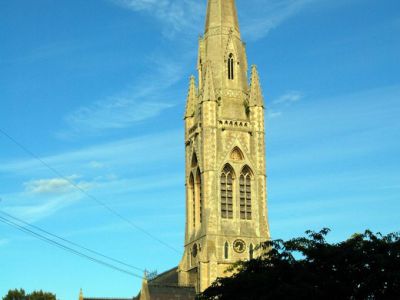
Saint John the Evangelist Catholic Church, Bath
Saint John the Evangelist Roman Catholic Church in Bath is situated on South Parade in the southeastern part of the city's centre, specifically in the Old Ham District. This church is distinguished by its striking Gothic-style spire, which rises prominently in the city's skyline. Despite its architectural significance, the spire has been a subject of controversy, with the renowned architectural critic Nikolaus Pevsner expressing disdain for its dominance in the cityscape. Pevsner notably criticized the church as exemplifying the Gothic revivalists' distaste for the Georgian style prevalent in Bath.
The church was designed and constructed between 1861 and 1863 by Charles Francis Hansom, a figure of historical importance in architecture. Charles was the brother of J. A. Hansom, famously known for inventing the Hansom cab. Both brothers were also involved in designing the Woodchester Mansion in Nympsfield, Gloucestershire, taking over the project after A. W. N. Pugin's resignation. This involvement has led to their recognition as prominent Roman Catholic architects of their era, particularly noted for succeeding in commissions initially passed over by Pugin.
A significant feature of the Saint John the Evangelist Church is its spire, which measures 222 feet (approximately 68 meters) in height. This spire was added to the structure in 1867 by Hansom, further enhancing the church's architectural prominence in Bath. The church, with its Gothic flair and historical associations, stands as a testament to the architectural shifts and religious landscapes of 19th-century England.
The church was designed and constructed between 1861 and 1863 by Charles Francis Hansom, a figure of historical importance in architecture. Charles was the brother of J. A. Hansom, famously known for inventing the Hansom cab. Both brothers were also involved in designing the Woodchester Mansion in Nympsfield, Gloucestershire, taking over the project after A. W. N. Pugin's resignation. This involvement has led to their recognition as prominent Roman Catholic architects of their era, particularly noted for succeeding in commissions initially passed over by Pugin.
A significant feature of the Saint John the Evangelist Church is its spire, which measures 222 feet (approximately 68 meters) in height. This spire was added to the structure in 1867 by Hansom, further enhancing the church's architectural prominence in Bath. The church, with its Gothic flair and historical associations, stands as a testament to the architectural shifts and religious landscapes of 19th-century England.
Want to visit this sight? Check out these Self-Guided Walking Tours in Bath. Alternatively, you can download the mobile app "GPSmyCity: Walks in 1K+ Cities" from Apple App Store or Google Play Store. The app turns your mobile device to a personal tour guide and it works offline, so no data plan is needed when traveling abroad.
Saint John the Evangelist Catholic Church on Map






Sight Name: Saint John the Evangelist Catholic Church
Sight Location: Bath, England (See walking tours in Bath)
Sight Type: Religious
Sight Location: Bath, England (See walking tours in Bath)
Sight Type: Religious
Walking Tours in Bath, England
Create Your Own Walk in Bath
Creating your own self-guided walk in Bath is easy and fun. Choose the city attractions that you want to see and a walk route map will be created just for you. You can even set your hotel as the start point of the walk.
Historical Homes Walking Tour
Apart from its Roman thermae, the city of Bath is renowned for its prominent residents who used to live here a long time ago. Their former dwellings – historical monuments in their own right – now offer a captivating glimpse into the city's glorious past.
Among the most famous of them, undoubtedly, is the Jane Austen Centre. This charming Georgian townhouse provides a fascinating look... view more
Tour Duration: 1 Hour(s)
Travel Distance: 1.6 Km or 1 Miles
Among the most famous of them, undoubtedly, is the Jane Austen Centre. This charming Georgian townhouse provides a fascinating look... view more
Tour Duration: 1 Hour(s)
Travel Distance: 1.6 Km or 1 Miles
Jane Austen Walking Tour
Jane Austen, 1775-1817, was a renowned British author. Her groundbreaking novels offer a witty and humorous look at Regency-era life. Austen's six novels have since inspired many popular TV adaptations and films.
Jane Austen lived in Bath from 1801 to 1806. Two of her novels, Northanger Abbey and Persuasion, were set in this beautiful Georgian city. While interiors have certainly been... view more
Tour Duration: 2 Hour(s)
Travel Distance: 2.5 Km or 1.6 Miles
Jane Austen lived in Bath from 1801 to 1806. Two of her novels, Northanger Abbey and Persuasion, were set in this beautiful Georgian city. While interiors have certainly been... view more
Tour Duration: 2 Hour(s)
Travel Distance: 2.5 Km or 1.6 Miles
Bath Introduction Walking Tour
The only English city designated a UNESCO World Heritage site, Bath is a gorgeous city packed with history. Artifacts have been found from the Bronze and Iron Age in the surrounding hills. The Romans were the first to build around the remarkable hot mineral springs at the beginning of the first century. They constructed a temple and baths here, and since then, people have flocked to Bath for its... view more
Tour Duration: 2 Hour(s)
Travel Distance: 2.5 Km or 1.6 Miles
Tour Duration: 2 Hour(s)
Travel Distance: 2.5 Km or 1.6 Miles
Georgian Architecture Walking Tour
Another prominent attraction of Bath is its wonderful Georgian architecture. Many a street and square here are richly adorned with distinctively stylish buildings. In large part, the city owes it to two architects – father and son: John Wood, the Elder, and John Wood, the Younger. Constructed mostly from Bath Stone, a creamy limestone obtained in Combe Down and Bathampton Down Miles, these... view more
Tour Duration: 1 Hour(s)
Travel Distance: 2.2 Km or 1.4 Miles
Tour Duration: 1 Hour(s)
Travel Distance: 2.2 Km or 1.4 Miles




